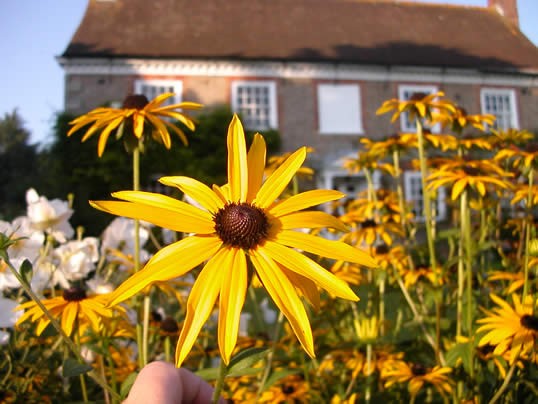Did you know that almost 50% of UK adults are engaged in gardening?
Or that domestic gardens account for nearly 25% of urban space?
Or that garden soils store almost 25% more carbon per unit area than arable soils?
All of this means that gardeners are well placed to notice and understand the effects of climate change. Our plants are affected by whatever the weather delivers and they can observe the changing climate every day in their gardens.

The following advice is taken from the 2017 RHS report entitled “Gardening in a changing climate”.
Opportunities & challenges of climate change for gardeners
- Warmer springs and autumns will extend the growing season and, therefore, some species will flower earlier and some will experience delayed leaf colouring or leaf fall. The growing season was around 10% longer in 2015 compared to the 1981 to 2010 baseline, and analysis of flowering times indicate that the growing season will continue to increase with rising temperatures. There will also be the need for more pruning, mowing and weeding.
- A longer growing season will allow for a wider variety of plant species to be grown, especially tender ornamentals and edible plants. Although, when attempting to grow different varieties, gardeners will face a continual trade–off between a longer growing season and the implications of extreme weather events, such as heavy rainfall damaging plant tissue.
- The amount of solar radiation available to the plant for growth has increased by around 5% relative to 1961–1990. This has been linked to a reduction in cloud cover.
- Extreme rainfall events might increase the rate that nutrients, particularly nitrogen are washed out of the soil. Therefore, the timing of fertiliser application should be carefully considered. When combined with heat stress in some areas, this could result in a reduction in plant growth. The leaching of nitrogen into public waterways may result in environmental problems such as algal blooms.
- Dry spells are projected to increase, and gardeners will need to consider methods of capturing water during intense rainfall events and storing it so that supplies can last for several months over the summer. Dry spells and rising temperatures will also increase the need for irrigation.
- It is expected that warmer conditions will favour the spread of existing pests and diseases, in addition to the establishment of new cases. Warmer conditions will be compounded by dampness and humidity following heavy rainfall, resulting in ideal conditions for the establishment of a variety of pests and diseases. Environmental conditions might result in stressful growing conditions for the plant, making them more vulnerable to attack. However, climate change will mean that populations of those pests and diseases who exploit frost wounds, for example, may struggle to survive.
Gardening in a Changing Climate – planting trees
Gardeners should be mindful that trees planted now might not be suited to the climate in 2050, for example.
In addition, increased climate variability on a season by season basis will mean that gardeners should think on much shorter timescales for tender ornamentals, as what grew successfully in one year might not do so well in the next.
However, gardeners are ideally placed to plant trees to soak up the increasing amount of carbon dioxide that is associated with a changing climate.http://www.guardian.co.uk/environment/2009/nov/26/trees-to-combat-climate-change
What can gardeners do?
- Green your living space. Wherever possible, plant a large tree or shrub and green up any bare patches. Trees and plants remove heat–trapping CO2 from the atmosphere, reduce the risk of flooding, and some species can even capture particulate pollution.
- Plant a diverse range of plants in your garden. Earlier flowering might disrupt host–pollinator associations, so plant a diverse variety of pollinator friendly plants with different flowering times. Use the RHS Perfect for Pollinators list to increase the number of pollen and nectar sources at different times of the year.
- Adopt new ways of growing. Green roofs and walls can result in year–round home energy savings due to a cooling effect in summer and an insulating effect in winter. Improve energy efficiency through use of new technologies and growing systems such as self–watering containers, solar powered garden products and smart phone devices linked to automatic monitors, sensors, LED light timers and irrigation systems. Also try to reduce the use of petrol–powered tools.
 Water use and management in gardens. Improve water capture and storage infrastructures with a larger capacity than standard water butts to ensure a sufficient water supply over the summer. Select plants better suited to the environment, or incorporate appropriate garden design strategies like rain– gardens and Sustainable Urban Drainage Systems (SUDS).
Water use and management in gardens. Improve water capture and storage infrastructures with a larger capacity than standard water butts to ensure a sufficient water supply over the summer. Select plants better suited to the environment, or incorporate appropriate garden design strategies like rain– gardens and Sustainable Urban Drainage Systems (SUDS).- Do not use peat. Peatlands store considerable amounts of carbon. Look, ask for and use peat–free composts. There are now some high quality products out there that work.
- Compost your garden and kitchen waste. Gardeners may wish to compost more garden and kitchen waste as this provides excellent nutrients for the garden, but thrown away as household waste, it ends up on landfill and produces potent greenhouse gases.
- Adopt the 4R’s. Reduce – the use of resources in your garden wherever possible Reuse – household materials and seasonal items year on year Recycle – garden waste, plastic, glass and metals and Reinvest – help stimulate demand for recycled products by buying recycled items.
- Avoid wherever possible the use of chemicals in your garden. As a first choice avoid the use of chemicals in the garden. If required, use products with a low carbon footprint.










0 Comments For This Post
1 Trackbacks For This Post
September 23rd, 2017 at 10:05 am
[…] Gardens hold our future Image: My Climate Change Garden […]